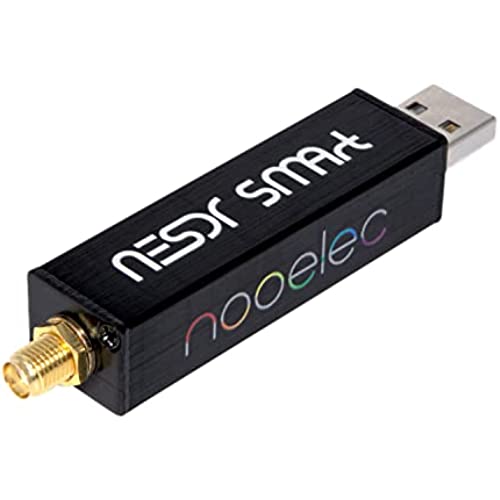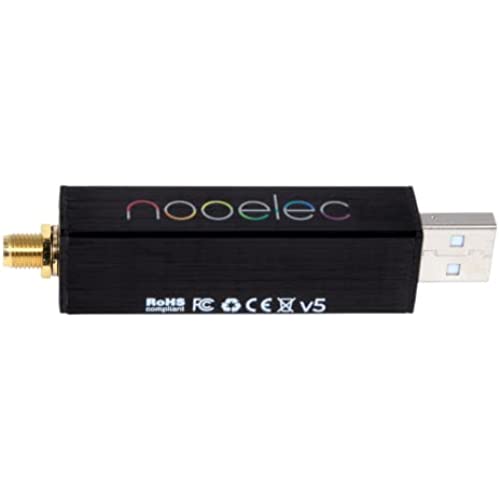











Nooelec RTL-SDR v5 SDR - NESDR Smart HF/VHF/UHF (100kHz-1.75GHz) Software Defined Radio. Premium RTLSDR w/ 0.5PPM TCXO, SMA Input & Aluminum Enclosure. RTL2832U & R820T2 (R860)-Based Radio
-

ddTaylor
Greater than one weekIt does what the listing says it does. The quality is very nice especially given the very moderate selling price. I especially appreciate the metal enclosure. Its quality is very solid and the USB and RF connectors are of good quality. The receiver works as well as any other RTL SDR I have used and offers reasonably stable frequency accuracy. I wouldnt expect this radio (or many other SDRs) to be highly accurate above VHF without the option for external reference standards. However, you can account for any frequency inaccuracies in software, so this isnt a real problem even when tracking satellites or performing basic radio astronomy. For the price, this is an excellent way to get your feet wet in SDRs. It is also flexible enough to add LNAs, up-converters, down-converters, filters and even improve the frequency stability through upgraded frequency/time standards. RTL SDRs are not just for getting your feet wet. With some DIY skills and commercially available parts, you can make an RTL SDR function well above its price-point. I like it.
-

WhatsTheHurry?
Greater than one weekI have both the NESDR Smart v4 and the NESDR Smartee v2 (the same but with bias tee built-in) and they both offer equal performance that is notably better than generic RTL SDR dongles from China. The 0.5 PPM accuracy of the temperature-compensated crystal oscillator (TCXO) is great (meaning that it tunes the exact actual frequency you select digitally and stays there) plus the noise level is 2-3dB lower than no-name products. Just as important, the number and strength of interfering signals in the form of images, spurs, and birdies across the bands is substantially lower in these Nooelec products. Well worth the extra few dollars.
-

Michael Thompson (strider_mt2k)
> 3 dayfits in a tight space and works very well. I really like this one
-

R. Klems
> 3 dayI had noticed that my piaware feeder hadnt been seen much traffic outside of 50nm of late. I swapped these in for the SDRs I had been using, and Im seeing traffic well over 200nm again. Ill have to see how they do long term, but so far, these are working great! I swapped this in late on 9/23, so you can see from the Flightaware stats in the picture, it doubled my reception!
-

WB9RRO
> 3 dayThe is a very good RTL-SDR. Works great. Much nicer( lower noise floor) than my old original E4000 dongle. Works great with the experiments in the book SOFTWARE DEFINED RADIO Using MATLAB and the RTL-SDR
-

Mr. Beau Cole
> 3 dayit does everything I need it to. frees up a two way radio that I typically use to monitor freqs. The high the freq you listen tot he hotter it gets. small CPU fan works well to solve that. not a complaint just a fact of life with electronics.
-

James
> 3 dayPerforms perfect for running DSD-Trunk listening to Motorola trunked radio.
-

P. Shinn
> 3 dayRead good reviews of this SDR, was expecting a great product. It sure looks nice, and well built. However, it does not work. Yes, I downloaded the driver I was supposed to, and installed it. No problem. Then, I downloaded the SDR software. No go. So, I downloaded another one of the 4 recommended software bundles to use with the NESDR. No go. Then, I downloaded the 3rd recommended software. No go. Cannot tell if it is hardware failure or I just cannot make any of the software talk to it. It does not matter if I am not a software engineer, a buyer should be able to install this and plug it in and it works. That is simply NOT the case. For the record, I am an electrical engineer and a P.E. and I know my way around computers. If I cannot make it work, how does the average user make it work? Edit: I should add that I also have one of the RTL-SDR.com dongles and it works just fine in the same computer. I suspect the NooElec dongle I received was defective. Thank you for the comments and suggestions. By the way- Amazons return policy is excellent!
-

Tom Goss
> 3 dayExcellent Item and appears to be up to NooElecs quality standards. Will research this and compare with my other R820T/T2 and E4000 tuners for my satellite projects.
-

Adam
Greater than one weekThe Nooelec RTL-SDR hardware works really well for RF monitoring and experimentation. I’ve bought three so far and they all work great. Very nice and premium-feeling aluminum outer case. Everything was nicely packaged. I’ve run these sticks on a Raspberry Pi for days at a time with no frequency drift. They all worked with zero or minimal ppm correction needed. If you want some RTL-SDR hardware this is a great option. It’s not perfect, though. While it is technically true that you can run two side by side on a Raspberry Pi, in practice I didn’t find this to be very practical. It will cover all four ports so forget about any other peripherals. When run in this configuration, the two SDRs will get really, really hot. With a little extra separation, they get warm but not hot. (I realize these are designed to run hot, but why do that if you don’t have to?) Even though you can run two side by side on a Pi, you’re better off using a USB hub instead in my opinion. The other problem I’ve found is something about the USB-A connectors doesn’t allow them to make a great connection with the host. I’ve tried multiple USB hubs, and of course connected directly to the Pi and in every case the dongles don’t feel like they are held solidly in place. They are quite loose and slightest bump will disconnect them or give a lousy connection to the host until they are wiggled around some to reseat them. This doesn’t appear to be a problem with the USB connector to the circuit board. It’s something with the connector design and how it mates with the ports — almost as if it’s slightly too long. If you plan on using these with a semi-permanent configuration, you should consider a bit of hot glue or epoxy to make sure they are held in place even if bumped around. I’ve had no problems with the SMA connectors and they feel solidly attached. So, in all it’s great hardware let down by a couple unfortunate but not insurmountable design decisions. As long as you keep these things in mind when you purchase, you’ll be fine.
